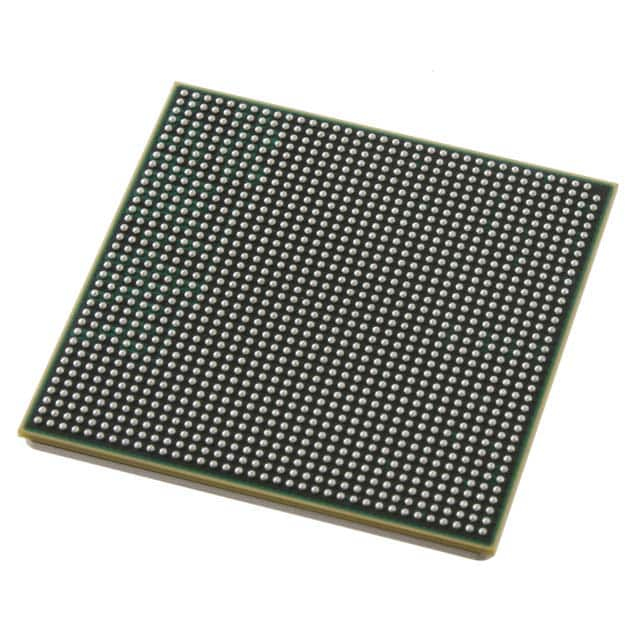Szczegóły produktu można znaleźć w specyfikacjach.

P3041NSE7PNC
Basic Information Overview
- Category: Integrated Circuit (IC)
- Use: Processor
- Characteristics: High-performance, low-power consumption
- Package: Plastic Ball Grid Array (PBGA)
- Essence: Advanced processing capabilities for various applications
- Packaging/Quantity: Individually packaged, quantity varies based on supplier
Specifications
- Manufacturer: NXP Semiconductors
- Architecture: Power Architecture
- Core: Quad-core
- Clock Speed: Up to 1.5 GHz
- Cache: L1 - 32 KB instruction and data cache per core, L2 - 512 KB unified cache per core, L3 - 2 MB shared cache
- Memory: DDR3/DDR4 SDRAM support
- Interfaces: Ethernet, USB, Serial ATA, PCI Express, I2C, SPI, UART, GPIO
- Operating Temperature: -40°C to +105°C
- Supply Voltage: 1.0V to 1.3V
Detailed Pin Configuration
The P3041NSE7PNC has a complex pin configuration with multiple pins dedicated to different functions. For a detailed pin configuration diagram, please refer to the manufacturer's datasheet.
Functional Features
- High-performance processing capabilities suitable for networking, telecommunications, and industrial applications.
- Low-power consumption design for energy-efficient operation.
- Integrated hardware acceleration for cryptography and security algorithms.
- Support for virtualization and real-time operating systems.
- Enhanced connectivity options with multiple interfaces.
Advantages
- Powerful processing capabilities enable efficient execution of complex tasks.
- Low-power consumption helps reduce energy costs and heat dissipation.
- Hardware acceleration enhances performance in cryptographic operations.
- Versatile connectivity options allow seamless integration into various systems.
- Support for virtualization enables efficient resource utilization.
Disadvantages
- Complex pin configuration may require careful attention during circuit design and PCB layout.
- High-performance processors may come at a higher cost compared to lower-end alternatives.
- Limited availability of alternative models from other manufacturers.
Working Principles
The P3041NSE7PNC is based on the Power Architecture, which utilizes a RISC-based instruction set. The quad-core processor operates at high clock speeds, executing instructions in parallel to achieve efficient performance. The integrated cache memory reduces memory access latency, improving overall system responsiveness. The processor communicates with external devices through various interfaces, enabling data transfer and control.
Detailed Application Field Plans
The P3041NSE7PNC is widely used in networking equipment, such as routers, switches, and gateways. Its high-performance capabilities make it suitable for handling large amounts of network traffic and complex routing algorithms. Additionally, it finds applications in telecommunications infrastructure, industrial automation, and embedded systems where processing power and connectivity are crucial.
Detailed and Complete Alternative Models
While the P3041NSE7PNC is a powerful processor, there are alternative models available from NXP Semiconductors and other manufacturers that cater to different performance requirements and price points. Some alternative models include: - P1020NSE5DFB: Dual-core processor with lower power consumption. - P5020NSE2MHC: Octal-core processor with higher clock speeds and enhanced features. - Freescale QorIQ T2080: Another quad-core processor with similar capabilities.
These alternative models provide flexibility in choosing the right processor based on specific application needs.
Word count: 436 words
Wymień 10 typowych pytań i odpowiedzi związanych z zastosowaniem P3041NSE7PNC w rozwiązaniach technicznych
Sure! Here are 10 common questions and answers related to the application of P3041NSE7PNC in technical solutions:
Q1: What is P3041NSE7PNC? A1: P3041NSE7PNC is a specific model of a processor designed by NXP Semiconductors. It is commonly used in embedded systems and networking applications.
Q2: What are the key features of P3041NSE7PNC? A2: Some key features of P3041NSE7PNC include a quad-core Power Architecture e500mc processor, integrated security engine, high-speed interfaces, and support for various communication protocols.
Q3: In which technical solutions can P3041NSE7PNC be applied? A3: P3041NSE7PNC can be applied in various technical solutions such as network routers, switches, industrial control systems, telecommunications equipment, and embedded computing devices.
Q4: What is the processing power of P3041NSE7PNC? A4: P3041NSE7PNC has a quad-core processor with each core running at a clock speed of up to 1.5 GHz, providing significant processing power for demanding applications.
Q5: Does P3041NSE7PNC support virtualization? A5: Yes, P3041NSE7PNC supports hardware-assisted virtualization, allowing multiple virtual machines to run concurrently on the same processor.
Q6: What communication interfaces are supported by P3041NSE7PNC? A6: P3041NSE7PNC supports various communication interfaces such as Gigabit Ethernet, USB, PCI Express, Serial RapidIO, and SATA, enabling connectivity with different peripherals and networks.
Q7: Can P3041NSE7PNC handle encryption and decryption tasks? A7: Yes, P3041NSE7PNC includes an integrated security engine that offloads encryption and decryption tasks, providing hardware acceleration for secure communication protocols.
Q8: What is the power consumption of P3041NSE7PNC? A8: The power consumption of P3041NSE7PNC depends on the specific usage scenario and configuration. However, it is designed to be power-efficient, making it suitable for various applications.
Q9: Is P3041NSE7PNC suitable for real-time applications? A9: Yes, P3041NSE7PNC is designed to support real-time applications with its deterministic performance and support for real-time operating systems.
Q10: Can P3041NSE7PNC be used in rugged environments? A10: Yes, P3041NSE7PNC is designed to operate reliably in harsh environments, making it suitable for industrial applications where temperature, vibration, and other factors may be a concern.
Please note that these answers are general and may vary depending on the specific implementation and requirements of the technical solution.

